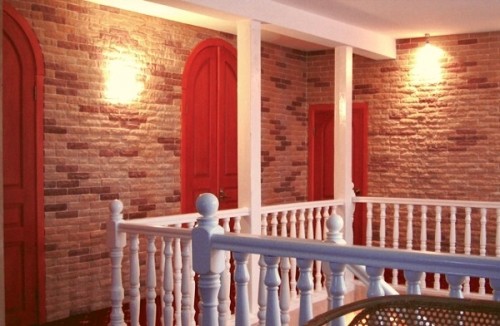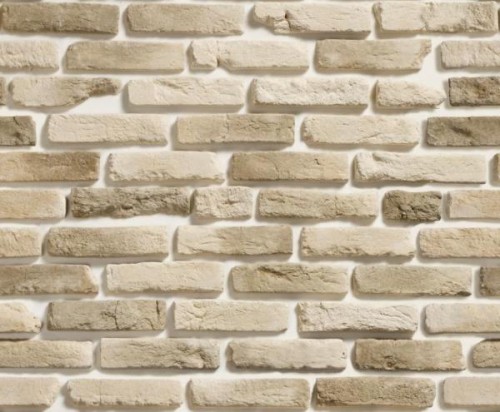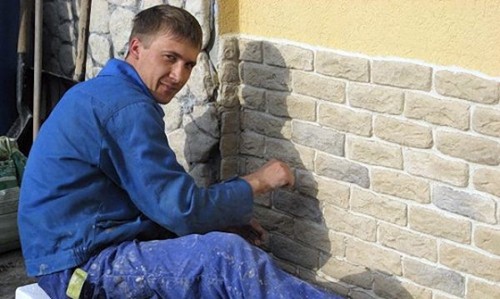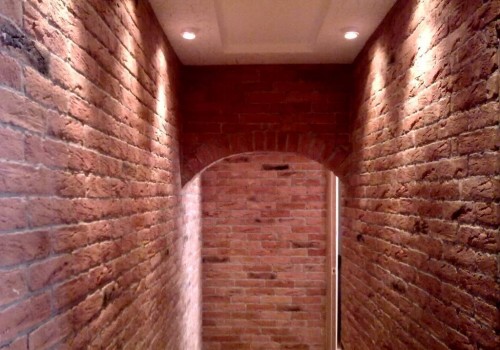
Decorative brick in the interior Building materials
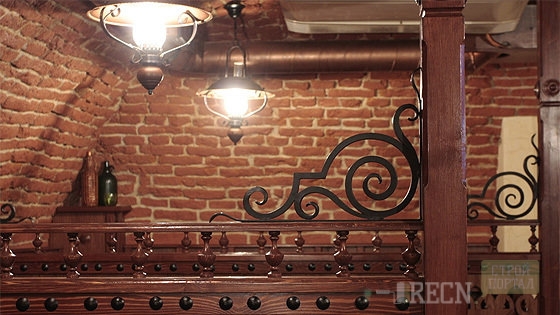
Decorative brick is a finishing material that allows you to mimic brickwork. Material is several times lighter than facing brick and significantly inferior in thickness. This allows you to flicker the room completely, without creating additional load on the foundation.
Content
It should be distinguished by a decorative brick from the decorative stone. The stone has a relief surface and differs in size and configuration.
Brick has a view of a rectangle with smooth edges. Diffuses are allowed in size to o, 3 mm and rounded corners. Many manufacturers produce artificially aged decorative brick.
For interior decoration, clinker tiles are used under the brick. With tiled work more convenient, it has a smaller thickness. The surface, lined with such a tile, will not differ from brick masonry or lining with decorative brick.
Types of decorative bricks
Clinker
Clinker decorative brick is the most expensive value. The main component of the composition is clay. The high cost corresponds to the quality of the brick and its characteristics. In the process of manufacture, the brick is subjected to burning, due to which it has high density and strength. The firing allows you to get an inhomogeneous color gamut. Clinker brick has a smooth surface.
Clinker brick is suitable for both internal and outdoor work. In the interior it is used to finish the premises, which are subjected to temperature drops - loggias, veranda, fireplaces and chimneys.
Brick has dimensions from 16 to 19 cm in width, 6 cm in height. Thickness 2 ± 0.5 cm. In addition to ordinary flat tiles, angular elements are produced.
Decorative brick manual forming based on cement and gypsum
Such a brick is manufactured by the preparation of the solution and the subsequent formation of bricks by filling in the form. When the mixture is seized and the product is gaining strength, it is released from the form and subjected to further drying. In fact, it is an ordinary artificial decorative stone, in shape, color and sizes resembling a brick.
The most fragile is a cement-based brick. It is only suitable for finishing indoors such places that are not exposed to strong load and frequent wash.
Cement brick is more durable. It is not afraid of moisture, which allows it to be used for outdoor decoration and for premises with high humidity.
Hand molding brick surface rough. Such a brick may have a relief surface.
How is a decorative brick for interior decoration
Unlike the decorative stone, the brick is more demanding in compliance with the overall style of finishing. The decoration decorative brick does not combine with a romantic gentle style.
Brick finish creates the impression of power and reliability and is considered prestigious. Recently, such a finish has become especially popular. Do not chase in fashion. Decorative brick should fit into the interior of your apartment and create a comfort, and not a feeling of cold dark walls.
Registration of living rooms, cabinets and bedrooms
- If there is a fireplace in the living room, there is no doubt about choosing a finish option. Decorative brick is quite appropriate here.
- Separate fragments are drawn up by a zone where the TV is located.
- When lining the wall is completely, it is important that the impression of devastation is not created in the room.
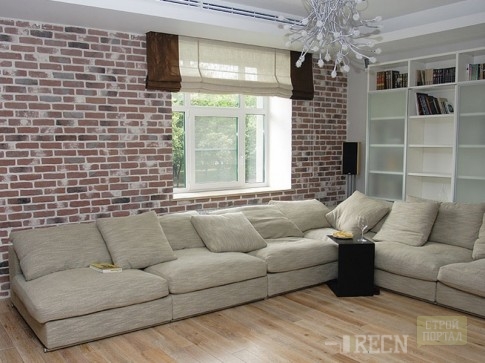
- In the bedroom, decorative brick is rare. But when combined with other finishes, creates a cozy design.

Decorative brick in the kitchen
- When designing a kitchen in an English style, complete wall lining is allowed. The necessary condition for this option is a large spacious kitchen and use in the finishing of other natural materials - wood, ceramics. Especially good here will look at decorative white brick.
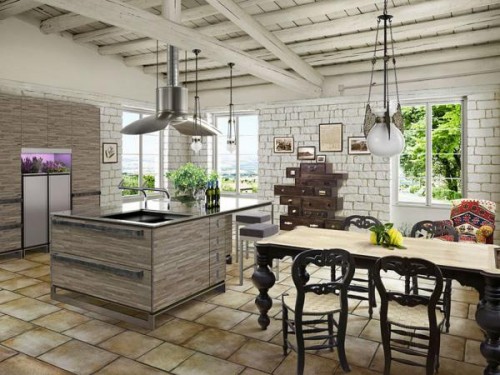 For the design of the apron over the working surface, only a smooth clinker brick is used. This zone requires frequent wet cleaning associated with high friction. For this reason, the use of bricks from plaster is unacceptable here.
For the design of the apron over the working surface, only a smooth clinker brick is used. This zone requires frequent wet cleaning associated with high friction. For this reason, the use of bricks from plaster is unacceptable here.- Facing artificially aged brick looks peculiar, but not always neatly. It is better to leave this option for a country house.
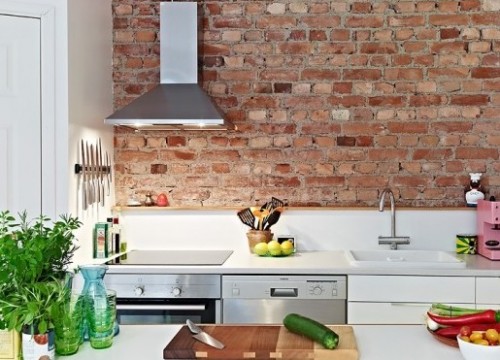
- When performing a wall in a dark background, a good complement will be designs from plasterboard, allowing you to create an additional backlight.
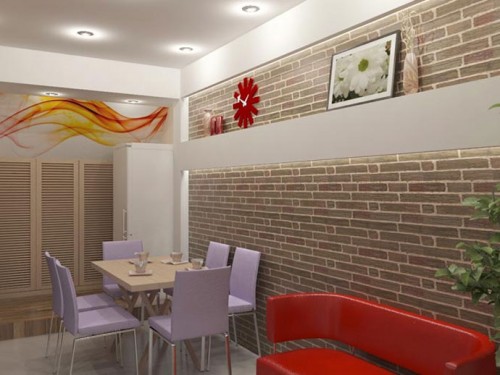
Finishing Corridors, Arch and Door Operactions
- The decoration of walls with decorative brick in the corridors is performed entirely or fragments. We are facing places that quickly pollute the doorways.

- In the corridor usually insufficient lighting. Use brick of light tones or white grout on a dark background. Article design sample is shown in the photo.
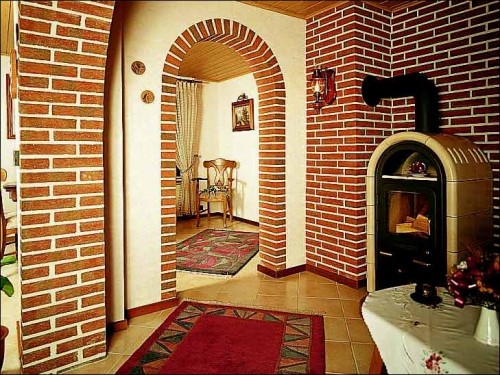
- Faceing walls from floor to ceiling looks gloomy and suitable for basement rooms.
Tips for work when laying decorative stone.
- Before the start of work, the walls should be aligned.
- Use suitable glue. For clinker and cement stone - cement-based glue. For gypsum stone - glue-based glue.
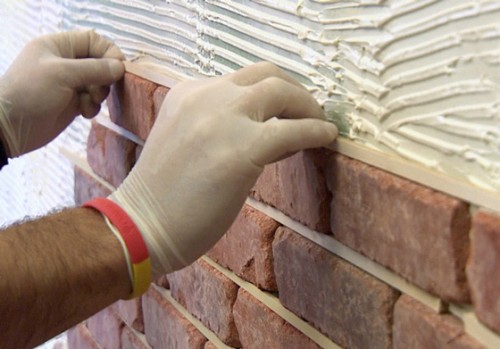
- When working with glue on a plaster basis, the surface is proper.
- The stone is stacked by the seam of the subsequent row located above the middle of the bottom stone.
- Clean the seams from the excess glue immediately after it is set.
- Special attention is paid to the grout of the seams.
- To give the stone saturated color and increase moisture resistance, treat the gypsum stone with varnish or impregnation.
- The clinker stone does not need additional coating with paint and varnish materials.
Examples of interior design.




